Looking for Donkey Facts? Here are 43 Interesting Facts About Donkeys
In this post, you’ll learn tons of donkey facts – everything from personality, diet, history, loyalty, and what they can do for work. You’ll even learn the difference between a donkey, a burro, and an ass.
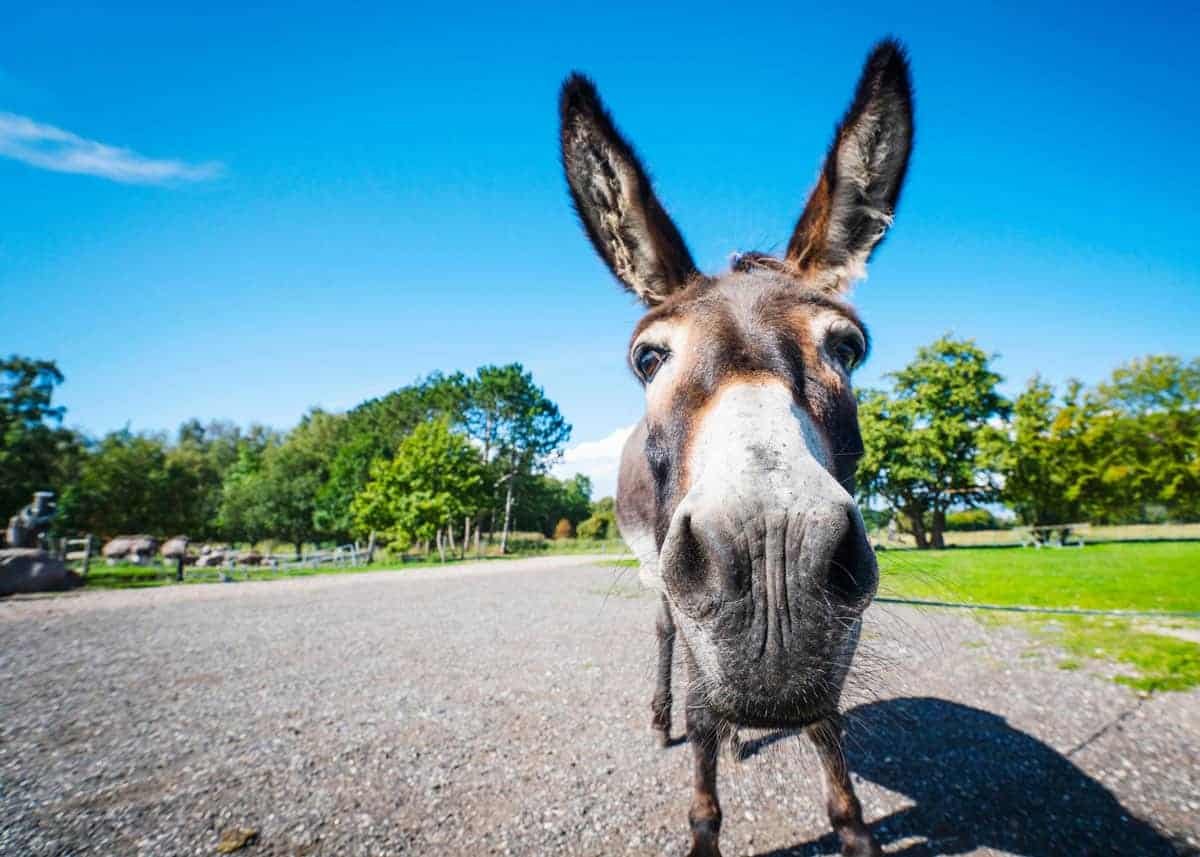
43 Facts About Donkeys
Found on every continent except Antarctica, donkeys are some of the most well-bred and well-known animals in the world. But how much do you know about these surprisingly deep and intelligent creatures?
Here are just a few donkey facts that might blow your mind.
1. How long have donkeys been around?
Donkeys have been braying since prehistoric times. They are in the same branch of the horse family as zebras, and those fossils go back millions and millions of years.
Donkeys have been recorded in everything from ancient Egyptian artwork to merchant scrolls about people traveling the Silk Road.
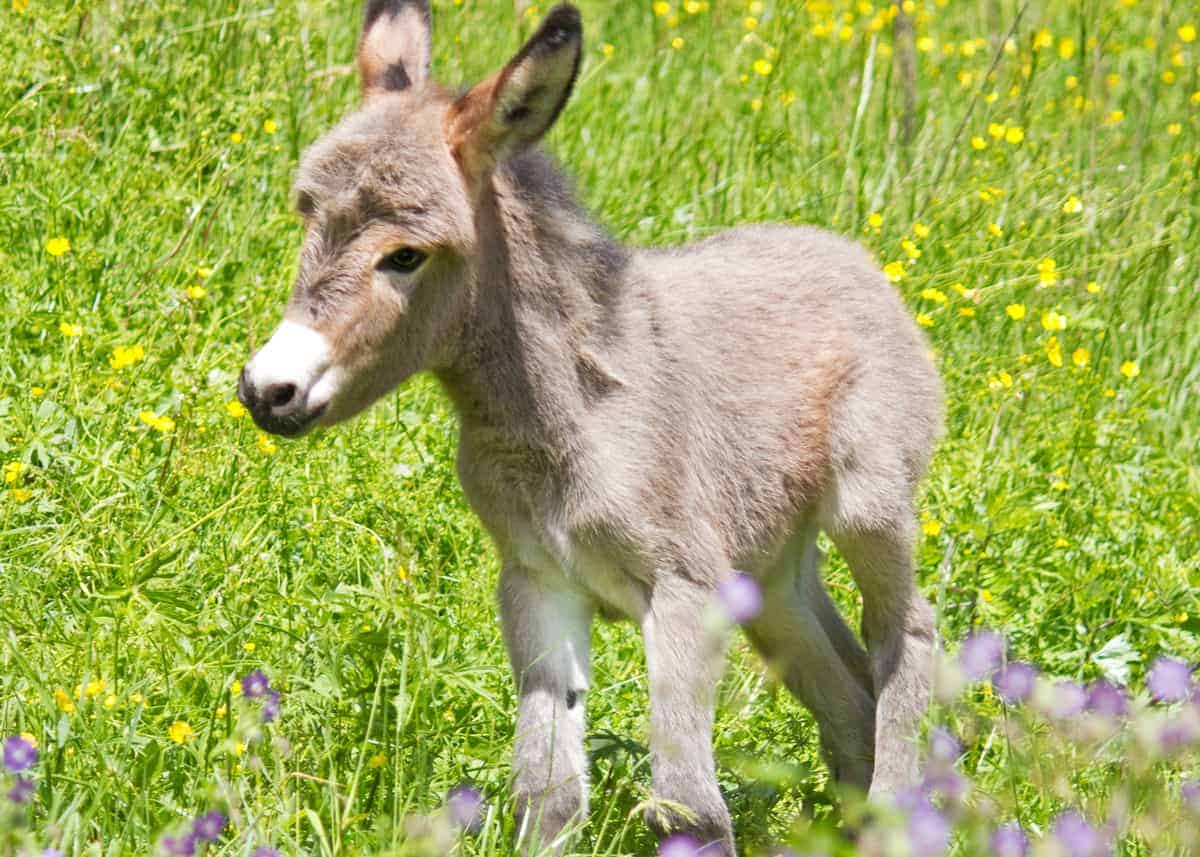
2. What’s the difference between a donkey, a burro and an ass?
There’s no difference. “Ass” was the original name for a donkey, and its scientific name is equus africanus asinus. For many years, “ass” and “she-ass” were completely normal and non-vulgar terms that people used to describe their pack animals.
“Burro” is just the Spanish word for donkey. Fun fact: “Burrito” means “little donkey” and was probably coined because of the similarities between a stuffed taco and a stuffed pack on the back of a donkey.
3. What are male and female donkeys called?
Male donkeys are called jacks. Female donkeys are called jennies or jennets.
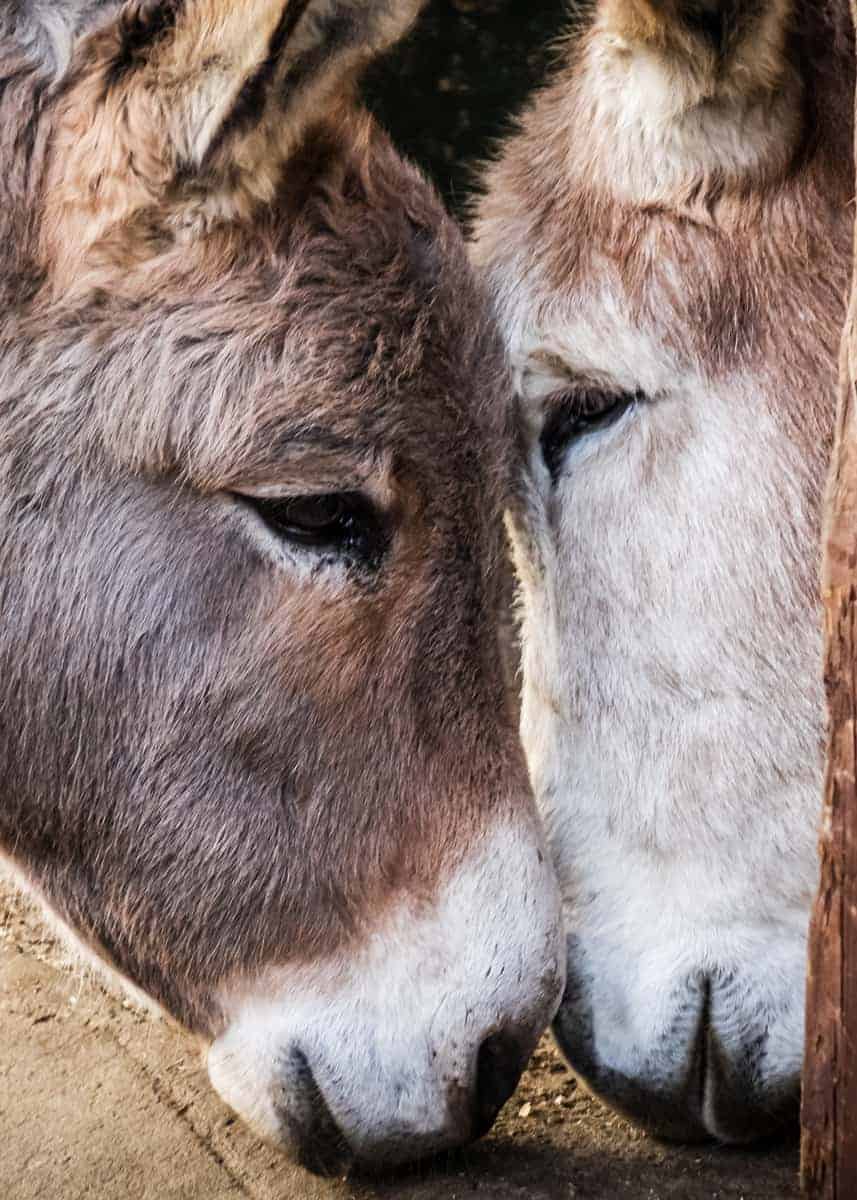
4. Are donkeys friendly?
Donkeys are loyal and loving creatures. Some people call them the dogs of the livestock world!
For starters, they’re great workers. They’ll haul your cargo all day long without complaint, and they’ll herd your children to safety just like they herd a flock of sheep. Some donkeys are even used for rescue missions when a hiker or climber goes missing in the mountains.
There are also certain breeds of donkeys that act more like pets than working animals. They’ll beg for treats and belly rubs, and they’ll engage in fun, playful behavior with their owners.
However, it should be noted that these sweet and affectionate donkeys are the domesticated kind. Wild and feral donkeys can be quite different.
5. What are wild donkeys like?
Wild donkeys are focused on survival rather than work or leisure. They travel in herds in warm desert environments and outbacks, and they can go long periods without food or water. They’re generally tougher than domesticated donkeys.
An interesting thing to know about wild donkeys is that they’re considered an invasive species. They tend to ruin local ecosystems by eating all of the grass, spreading weeds with their fur and eroding all of the soil with their hard hooves.
They’re a particular problem in Australia: More than five million wild donkeys roam the land, and they are considered such pests that it’s legal to kill them.
6. Are donkeys dangerous? Are they aggressive?
While generally sweet-natured, donkeys can have a bit of a kick to them. Their legs are very powerful and used to scare away predators, so you don’t want to get caught behind a donkey that’s feeling threatened.
Donkeys can also be aggressive about things like territory. This is especially common in young male donkeys. They’ll claim a field or pasture and behave threateningly towards any animals that disturb it.
Another notable feature of donkeys is their stubbornness in the face of danger. While other animals will flee from a wolf or snake, donkeys will stare them down in an act of silent defiance.
They don’t run very fast, so this is a form of offensive defense. They try to intimidate the other animal into leaving them alone.
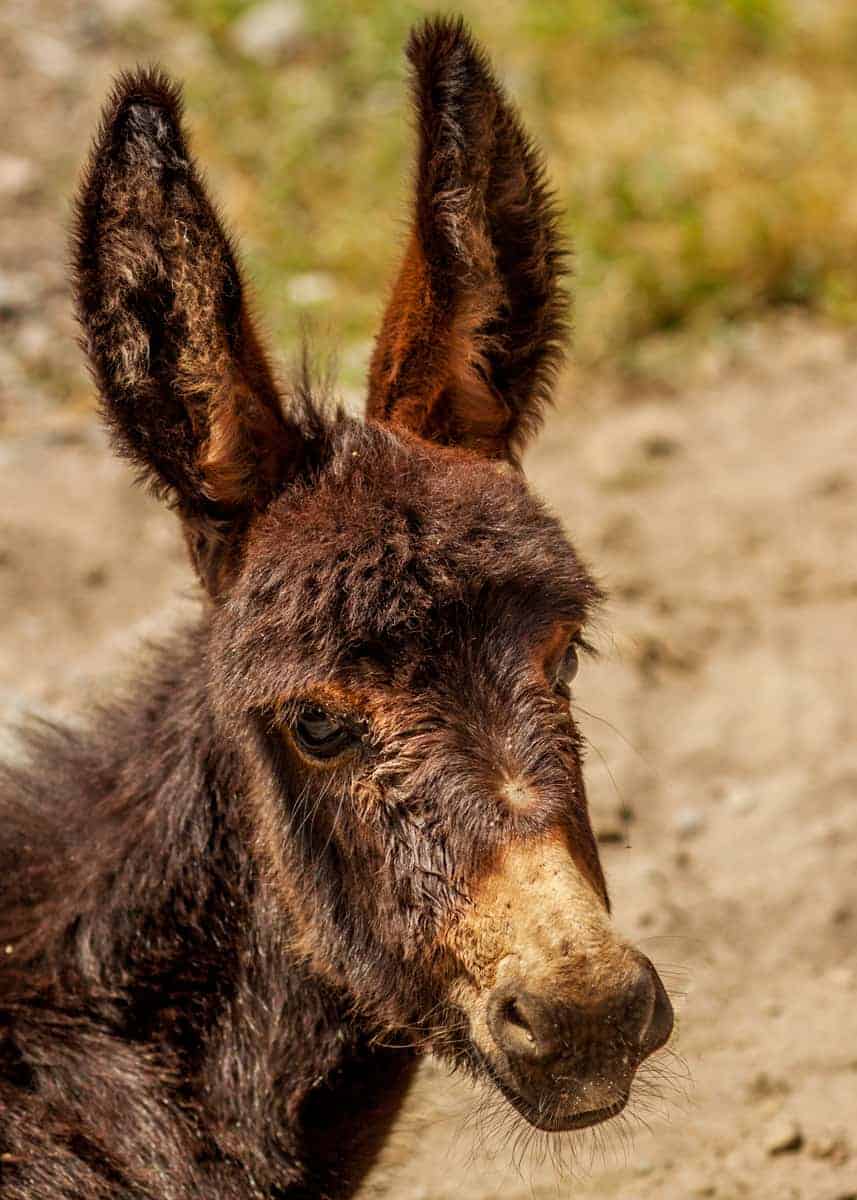
7. Why do donkeys kill coyotes?
It depends. If they’re being used as a herd animal to guard a flock of sheep, they’ll take their job very seriously, and this includes stomping on any trespassing coyotes who want to take a nip.
Donkeys also have a natural dislike of foxes, coyotes, wild dogs, and other members of the canid family. They can be taught to tolerate them, but their instincts will never really go away.
8. Are coyotes afraid of donkeys?
It’s true that coyotes aren’t very fond of donkeys. The enmity goes both ways. However, it’s probably an exaggeration to say that coyotes actually fear them. They’ll still try to slip past a fence even if they know that a donkey is on guard duty; they just bank on not getting caught as they slink among the sheep.
This suggests that there isn’t any kind of predator/prey relationship between donkeys and coyotes. They simply don’t get along.
9. What uses do people have for donkeys?
Donkeys can be used for a lot of things, including
- Carrying cargo. Whether it’s bricks, fruits, vegetables, logs, stones, or personal luggage, a donkey can get it from Point A to Point B.
- Leading carts. Donkeys are used a lot like horses and mules in this way.
- Guarding and herding. Just ask the coyotes about the usefulness of a guard donkey.
- Breeding. Donkeys can be bred with several other species to create hybrids. This gives them immense value as studs and moms.
- Tourism. Donkeys are a staple of things like mountain tours and trail walks; not only can they be used as personal porters, but they can also guide the way across unstable terrain with their sure-footed strides.
10. How are donkeys measured?
Rather than feet and inches, members of the equine family are measured by “hands.” According to legend, this was started by a farmer who didn’t own a ruler, so he used the length of his palm to measure all of his horses and donkeys.
One hand is equal to four inches. This means that a donkey measuring 11 hands is 44 inches or 3.6 feet tall. This would be written as “11 hh” like a real unit of measurement.
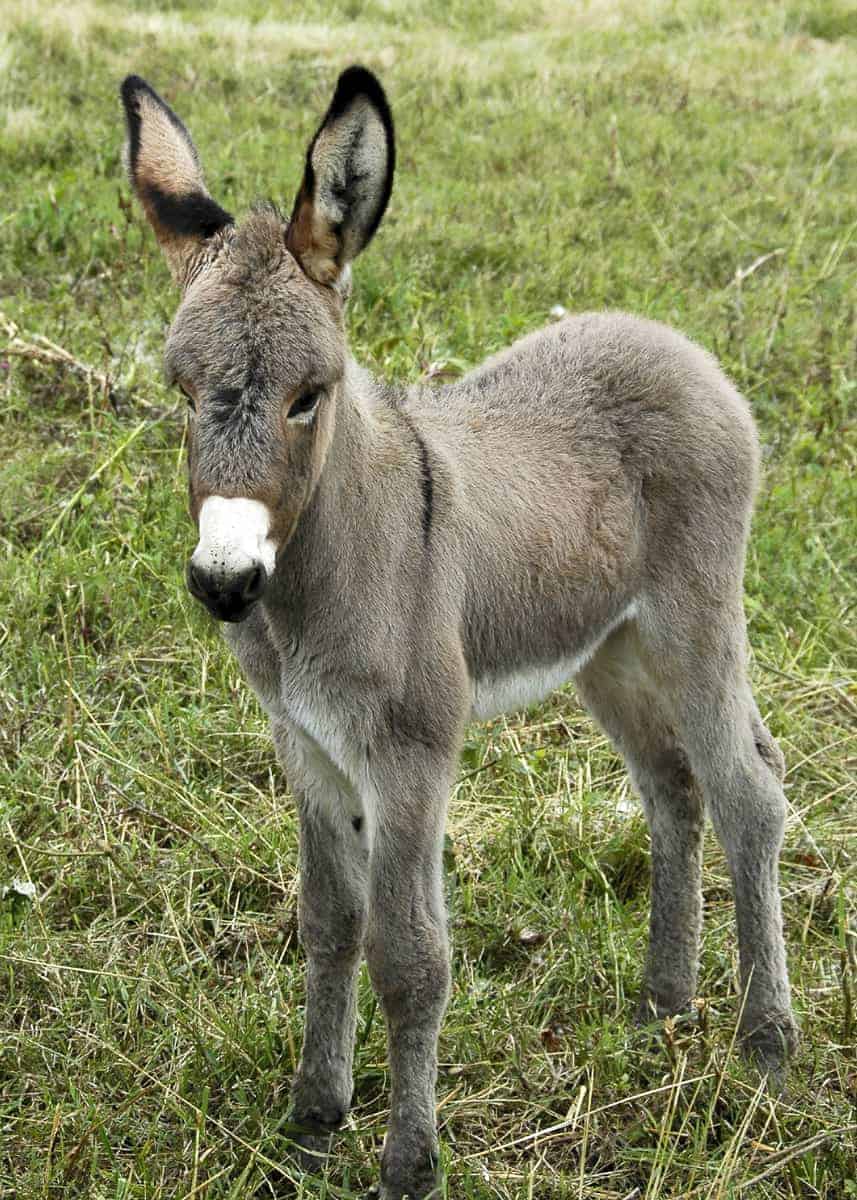
11. How many breeds of donkeys are there?
From the tiny donkeys hauling carts in Spain to the big black donkeys that perform rescue missions in the rocky cliffs of Italy, there are a lot of donkeys in the world. In fact, there are so many that it’s hard to keep track of them.
According to the Domestic Animal Diversity Information System (DAD-IS), there are 189 donkey breeds in existence.
However, this number tends to fluctuate since there are simply so many species and sub-species that accounting for all of them is nearly impossible. Breeds are constantly added, removed, modified, and re-classified. It’s a zoo out there.
12. What are the most popular donkey breeds?
- Mammoth donkeys are used for studding. Their large size makes them a valuable choice for breeders, so they’re bought, sold and traded like high-class horses.
- Miniature donkeys are popular pets. They have cute appearances and gentle personalities, so they’re quite at home at farms, fairs, equine shows, and petting zoos.
- Grand Noir du Berry donkeys are used for hauling and riding. They’re strong and resilient while also being quite placid, so they’ll go where directed and work hard for their owners.
- French Poitou donkeys are famous for their long and stylish coats. It looks like they have hair!
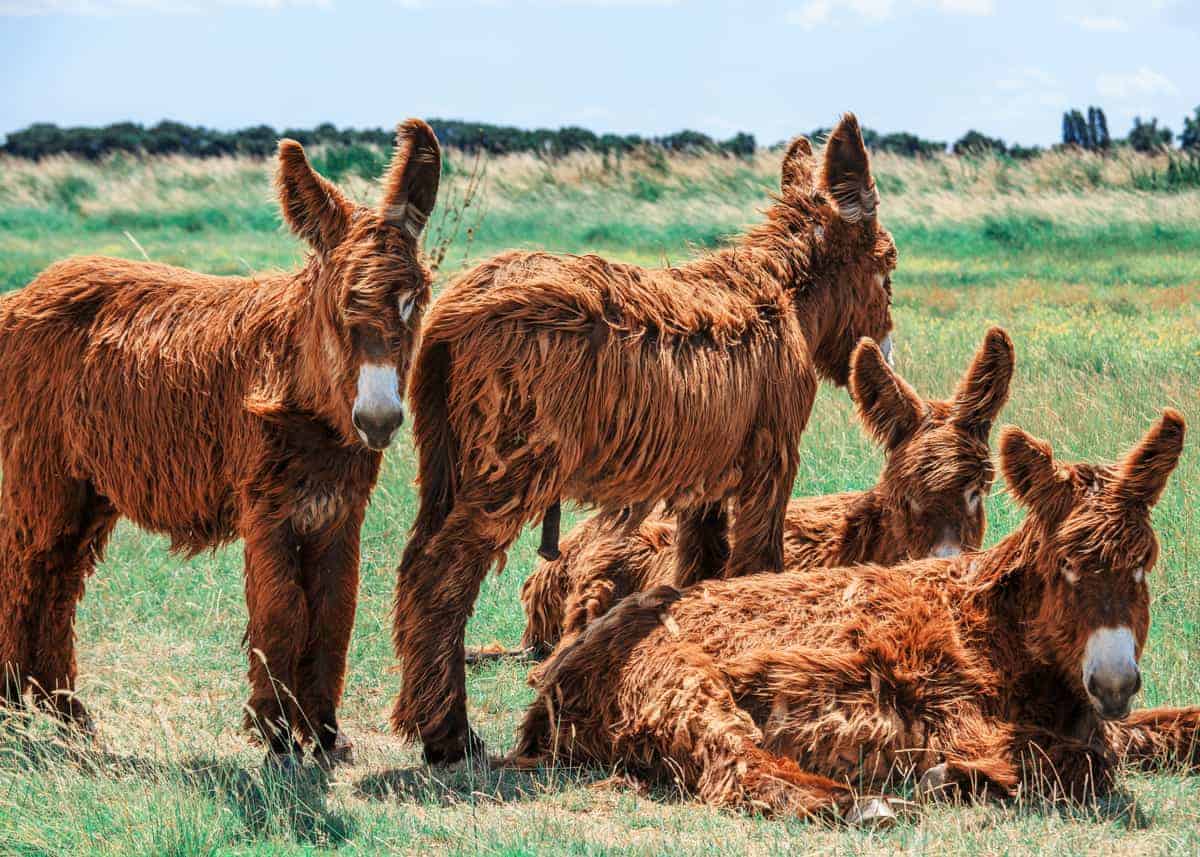
13. Where do donkeys live?
Wild donkeys are mostly found in the deserts of northern Africa and the Middle East. There are also thriving communities in the warmest, driest parts of Asia and Australia.
Domesticated donkeys can be found just about everywhere in the world.
14. What do donkeys eat?
Donkeys are herbivores. They like to munch on grasses, grains, oats, and barley straw. Domesticated donkeys are usually fed hay, but they enjoy special treats like apples, pears, beets, bananas, bread, and molasses.
If you plan on feeding a donkey for a while, however, watch out. They have hearty appetites and can consume as much as 6,000 pounds of food per year. This is part of the reason why they’re considered an invasive species:
Whenever wild donkeys move to a new area, they tend to gobble up everything until it’s completely decimated.
15. Can donkeys eat banana peels?
Yep! Donkeys love bananas, and they aren’t put off by the bitter taste of the peel like humans are. Many donkeys will take the whole thing right out of your hand.
16. Do donkeys get cold?
Donkeys are vulnerable to the cold in two ways. First, they’re naturally suited to warmer environments. This is why so many wild donkeys are found in African and Middle Eastern deserts. They like to be warm.
In addition, donkeys have thin coats that don’t offer a lot of protection in the winter. One study on hair samples from donkeys, horses, and mules revealed that donkeys don’t get a “winter coat” as their cousins do. They keep the same coat throughout the year, so when the cold winds start blowing, they shiver a lot more than other creatures on the farm.
17. Are donkeys good pets?
Donkeys make great pets!
In fact, a growing number of people are buying donkeys for companionship rather than work. They don’t need help with carrying firewood or pulling a cart; they just want a fun, friendly animal to brighten their days.
18. Are donkeys loyal?
Donkeys can be very loyal once they’ve formed a bond with you. As herd animals, they’re always happiest in social groups, and it’s common for them to “adopt” humans and kids into their own little families.
A donkey that loves you will follow you around like a puppy. Donkeys have also been known to form friendships with other donkeys. These pairs spend all of their time together as they graze the pasture or plod down to the market.
They’ll also groom each other and exchange little nips and nuzzles after they’ve been apart. They won’t do this with anyone else; they won’t indiscriminately nuzzle anyone in their pasture. They save their affection for their best friend.
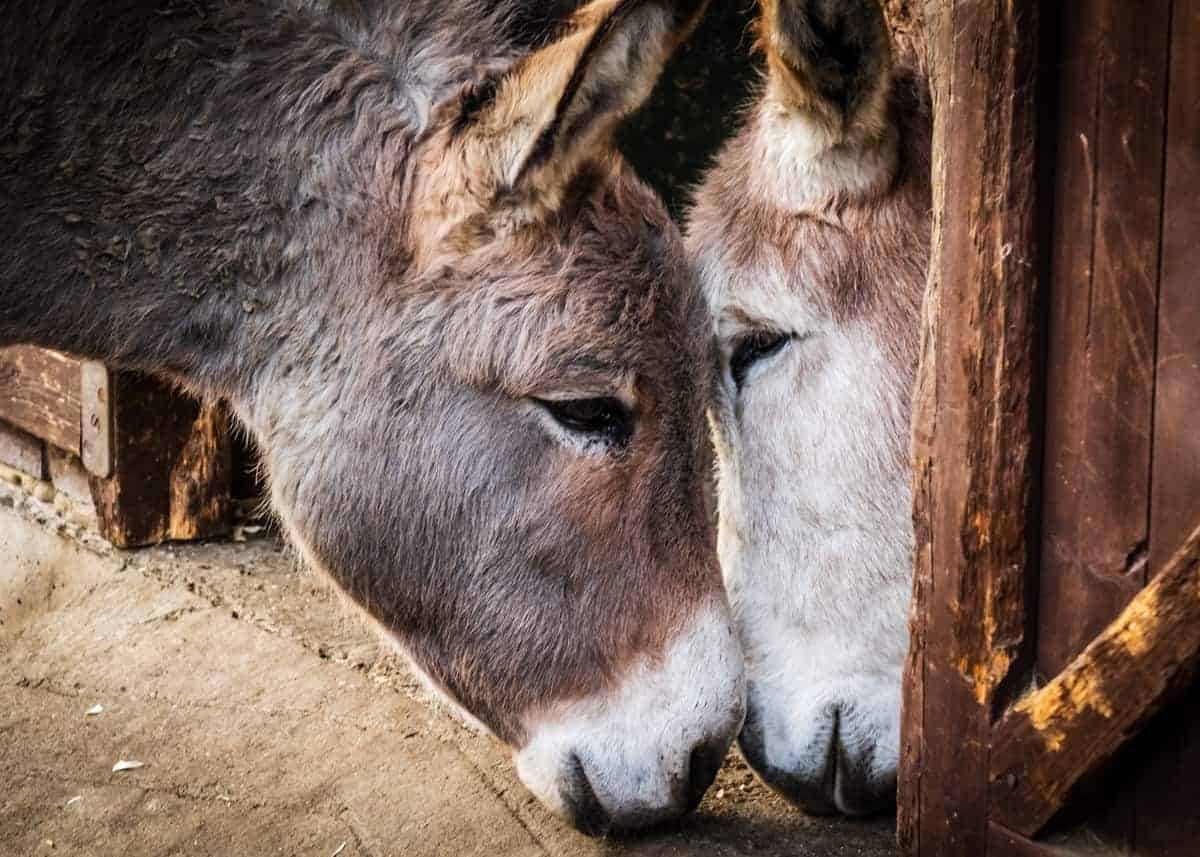
19. Are donkeys smart?
Donkeys are quite intelligent. They can be trained to respond to dozens of different voice commands, and they have amazing memories that can recognize a person or route that they haven’t seen for years. They’re also adept at solving problems.
Donkeys can recognize an obstacle in the road and change their course before they reach it, even if this means taking a longer way around. They can think and plan. They also have good balance; they instinctively understand the weight distribution of their cargo and how it affects their stride.
20. Why do donkeys have big ears?
Donkeys are known for their big, pointed ears, but these features are more than just goofy-looking head toppers. Donkeys use their ears to cool down when they get overheated, and this is important since so many of them live in desert climates.
Additionally, their ears can tell you a lot about how they’re feeling. Pointed ears are signs of an alert or curious donkey; flat ears are used to signal fear, aggression, nervousness, or sickness.
21. How often do donkeys reproduce?
Female donkeys have one of the longest gestation periods in the entire animal kingdom. They’re pregnant for anywhere between 10 – 14 months!
On top of that, they usually only have one foal at a time, and they aren’t interested in reproducing again until their baby grows up a little. One of the first things learned by a donkey breeder is patience.
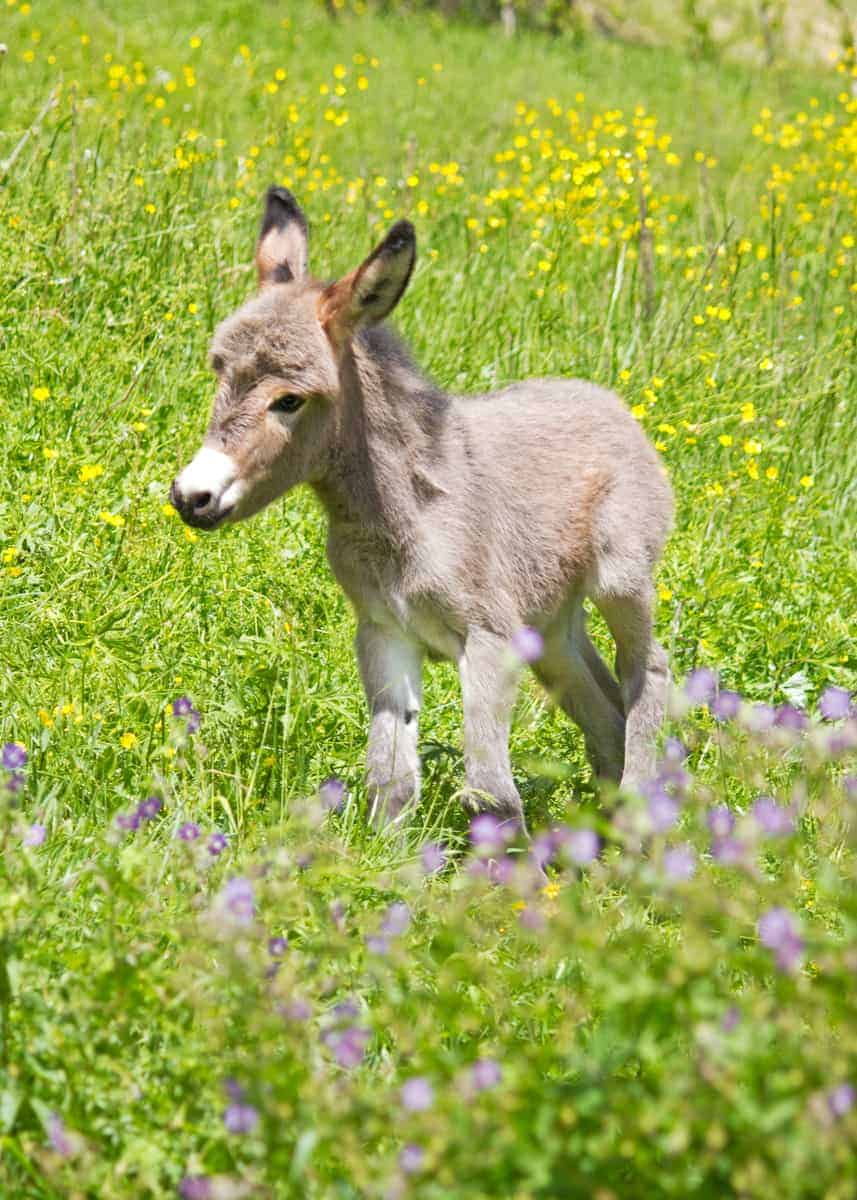
22. Can donkeys have twins?
It’s rare, but a female donkey will occasionally give birth to twins. This accounts for less than two percent of all pregnancies.
The babies are often fraternal rather than identical: They’ll be different colors or genders, or one foal will be healthy while the other is sickly.
23. What types of donkey hybrids exist?
Donkeys can be cross-bred with several different species, but there are quirks to each kind of coupling. Here’s a rundown of the most common hybrids:
- Mules. These are created with a male donkey and a female horse. They’re valued as hard, tireless workers, but they’re infertile, so mules can’t create more mules. You have to cross the male donkey with the female horse.
- Hinnies. These are the result of breeding a male horse with a female donkey. They’re a lot like mules, but they’re smaller and stronger. They’re also infertile.
- Zonkeys. These are crosses between donkeys and zebras. They have a very unique appearance with brown bodies and black-and-white striped legs, so you can tell that you’re looking at a hybrid species right away. They’re pretty rare compared to other hybrids.
24. How much does a donkey cost?
The price of a donkey depends on its age, gender, breed, and sexual maturity. An older donkey meant for labor might be as cheap as $100, but a young and fertile breeding donkey can cost three times as much.
If you’d like to purchase a mother with her foal, that will cost you between $1,000 – $2,000. An extremely rare breed of donkey might have a price tag of $3,000 or more.
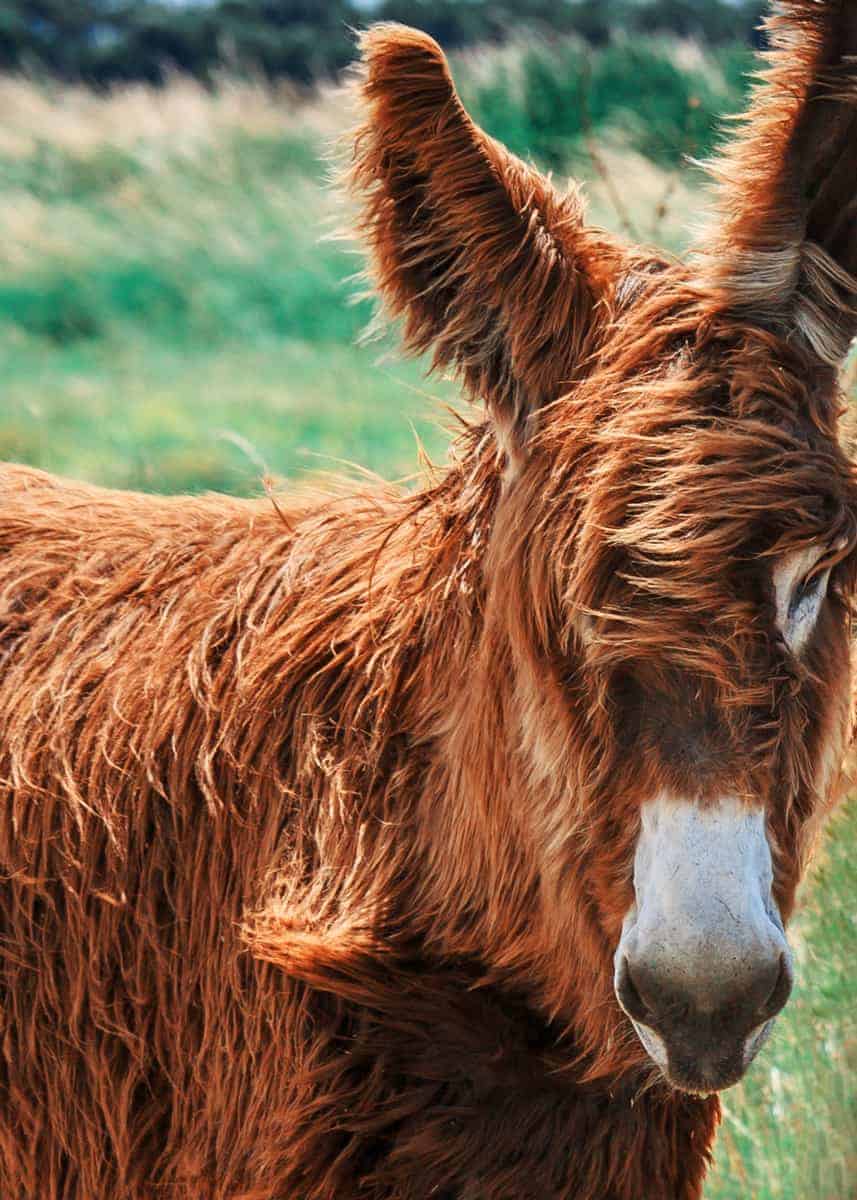
25. How much weight can a donkey pull and carry?
Generally speaking, donkeys can pull about twice their body weight across flat, even terrain. They’ll have more difficulty going up and down hills.
As for what they can withstand on their back, an average-sized donkey (11 hh) can carry an average-sized person (150 pounds). For bigger loads, you’ll need a bigger donkey.
26. What is the difference between a donkey and a pony?
Donkeys and ponies are completely different breeds.
They’re both descended from the equidae branch of the family tree, but they’re more like cousins than brothers. They differ in everything from size to chromosome count.
27. What is the largest breed of donkey in the world? How big is it?
The biggest donkeys are American mammoths. Also known as “mammoth jacks,” they have to measure at least 4.5 feet to be officially registered under the name.
They came into existence after George Washington started breeding and studding especially large donkeys; he had a kind of side business for people in the area, and before anyone knew it, they’d created a long-lasting donkey breed.
28. What is the record for the biggest donkey in the world?
The single biggest donkey is the world is an American mammoth named Romulus. He measures 17 hands (5.6 feet) from the bottom of his hooves to the top of his withers, and he weighs a staggering 1,300 pounds.
He also has a brother, Remus, who is just a few inches shorter than him. They live on an American farm and guard the livestock.
29. Are there miniature donkeys?
Miniature donkeys are small donkeys that are commonly bred as pets and show animals. To be officially classified as “miniature,” they have to measure no more than 36 inches tall.
Despite their name, miniature donkeys aren’t that tiny. They still weigh between 200 – 400 pounds, so they aren’t toy-sized animals that you can carry in your backpack.
However, miniature donkeys are so cute and playful that it’s easy to see why people coo over them. They make great companions for kids, and since they’re too small for backbreaking labor, they’re usually socialized as pets rather than used as work animals. They’re also quite popular in shows and equine events.
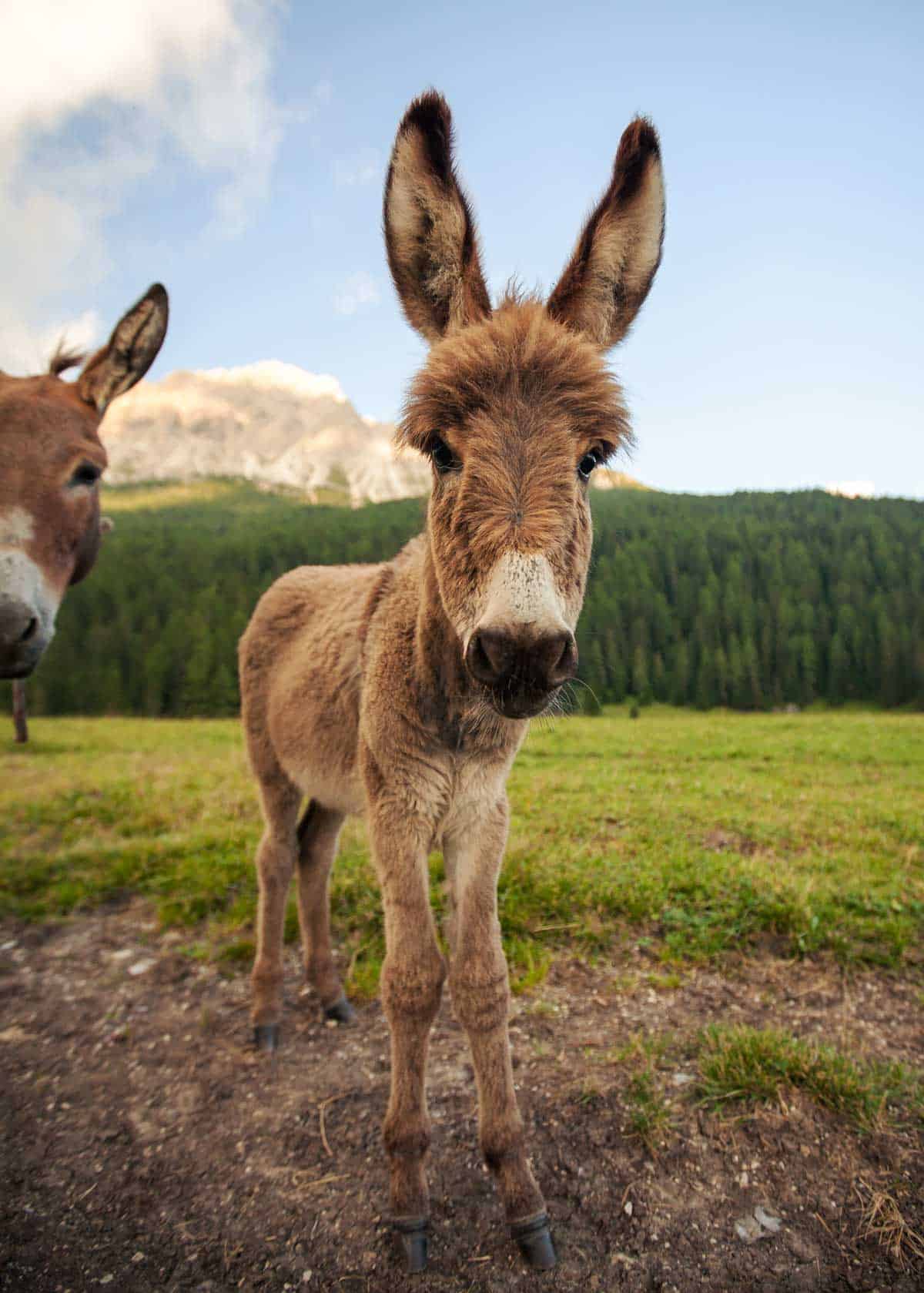
30. What is the record for the smallest donkey in the world?
The smallest donkey in the world is named KneeHi. He’s a miniature Mediterranean donkey that measures just 25 inches, and he’s officially recognized by the Guinness Book of World Records for his small stature.
31. Are white donkeys rare?
White donkeys are extremely rare. There are less than a hundred of them in the entire world, and most of them live on the island of Sardinia. They have white or white-blonde coats with blue or pink eyes, and they’re often less than three feet tall.
It’s rumored that they found a home in Sardinia after being shipwrecked there during overseas transport. Another rumor has it that they were shipped to Sardinia as a gift from an ancient Egyptian pharaoh.
32. Do donkeys sleep at night? Do they sleep standing up?
Yes. Donkeys keep a normal clock and will go to sleep at night with the other farm animals, but they snooze while standing up.
While it’s not uncommon to see them relax in the sun or take a nap laying down, they prefer to stay on their feet. As for how they’re able to do it, there’s a special part of their brain that maintains their balance even when they’re unconscious, so they don’t need to lie down as other animals might.
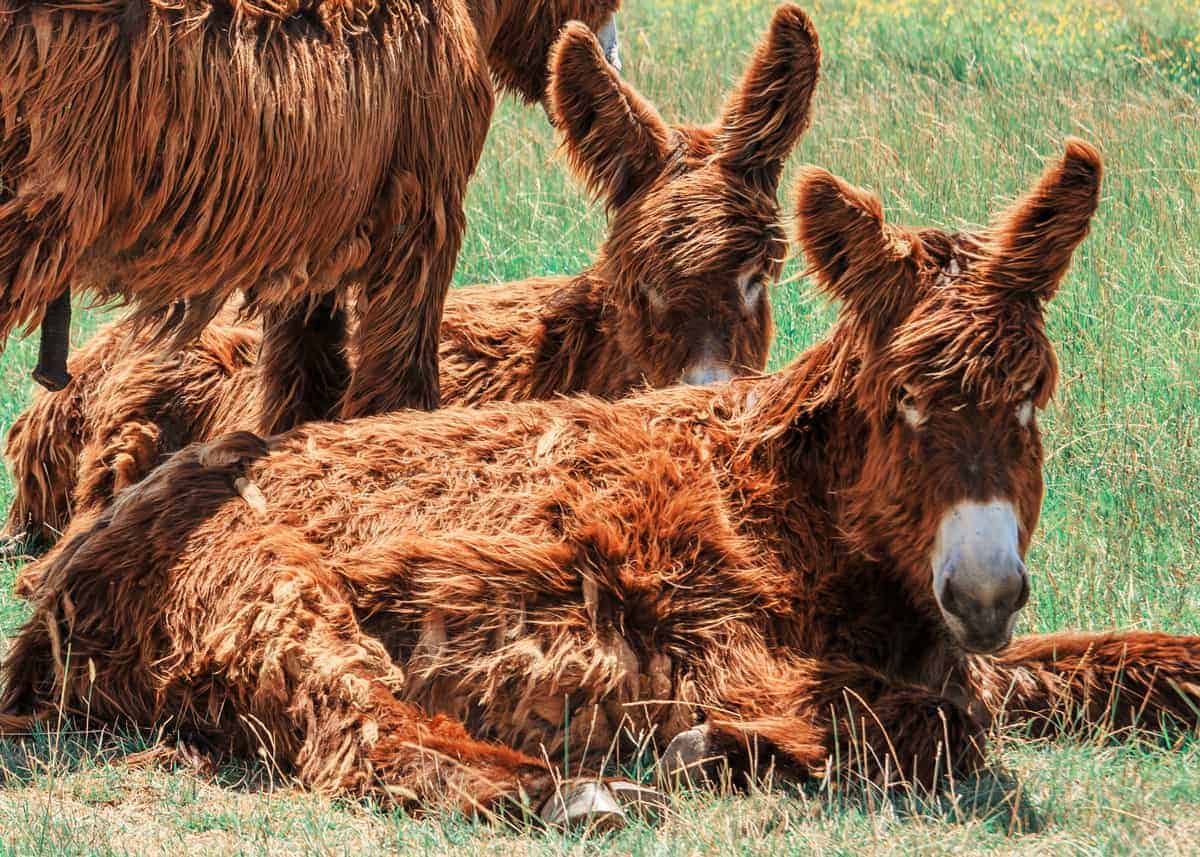
33. Can you ride a donkey?
Yes. Donkeys are placid creatures that can be trained to transport passengers just like horses, camels, and mules.
In fact, you’ll see a lot of donkey-riding in tourism packages when people are exploring the caves of Peru or the cliffs of Pakistan. Donkey rides can be a big draw for people who are looking for a little adventure.
34. Are donkeys better than horses?
Five different people will have five different opinions on this. However, buying a donkey could definitely be considered an alternative to buying a horse.
They can carry the same burdens, but they don’t spook as easily; they’re just as smart and loyal, but they won’t require the same kind of maintenance. At the end of the day, however, it’s up to you. Both species have their pros and cons.
35. What’s a good name for a donkey?
Many people name their donkeys after something related to Mexican or Spanish culture, so you’ll see a lot of “Burrito,” “Burro” and “Poncho.” It’s also common to find donkeys named after popular characters like Eeyore. Puns are another way to have fun with donkey names.
Who could resist a donkey named Don Quixote?
36. When is a donkey called a jackass?
A “jackass” actually refers to a mule and not a donkey. It has this nickname because mules are created by cross-breeding a male donkey and a female horse, and male donkeys are called jacks.
37. Can donkeys live alone?
Donkeys can survive by themselves, but they’re happier with companionship. Don’t forget all of the sweet tales of donkeys having best friends for grooming and grazing!
Their need for socialization is also why wild donkeys travel in herds. The herds are usually comprised of one male with an assortment of females and foals, and they’ll work together to find food and shelter as they explore new territories.
Occasionally, a herd will have more than one male, but these extra guys will always be submissive towards the main and dominant male.
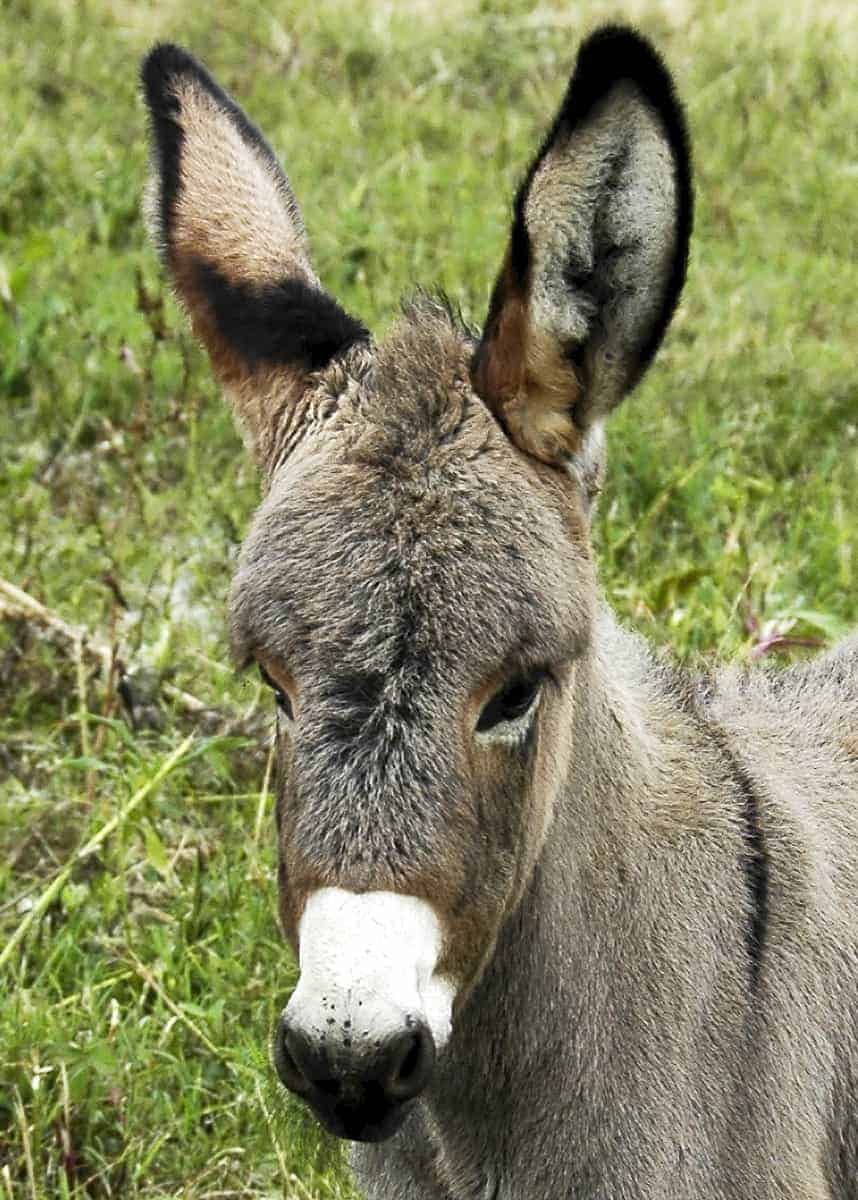
38. Why do donkeys bray?
You’re probably familiar with the loud bray of a donkey. But did you know that there have been actual scientific studies about these hee-haws? For example, according to the Acoustical Society of America, donkeys are one of the only species that can make noise while they’re breathing in and out.
“Donkey vocalizations (…) appear to be unique among the Equidae in that signature sound is produced during both air intake (the hee) and air outflow (the haw).” As for why donkeys make these vocalizations in the first place, there are a variety of reasons.
Sometimes, it’s to warn everyone of another animal in the area. Other times, it might be to call together a herd that’s scattered through the savanna.
39. Can donkeys be milked?
Like many mammals, female donkeys produce milk, and it can be collected and consumed by humans. It can also be used in dairy products. There’s a certain type of cheese called “pule cheese” that’s made with donkey milk.
One of the benefits of donkey milk is that it’s completely hypoallergenic, so it can be enjoyed as an alternative to cow milk by people with food allergies and sensitives. There are even pediatric hospitals that give donkey milk to babies because it’s less likely to upset their delicate stomachs.
Historically, donkey milk has also been used in cosmetics and medicinal remedies. One of the first people to sing the praises of donkey milk was none other than Hippocrates, the father of modern medicine.
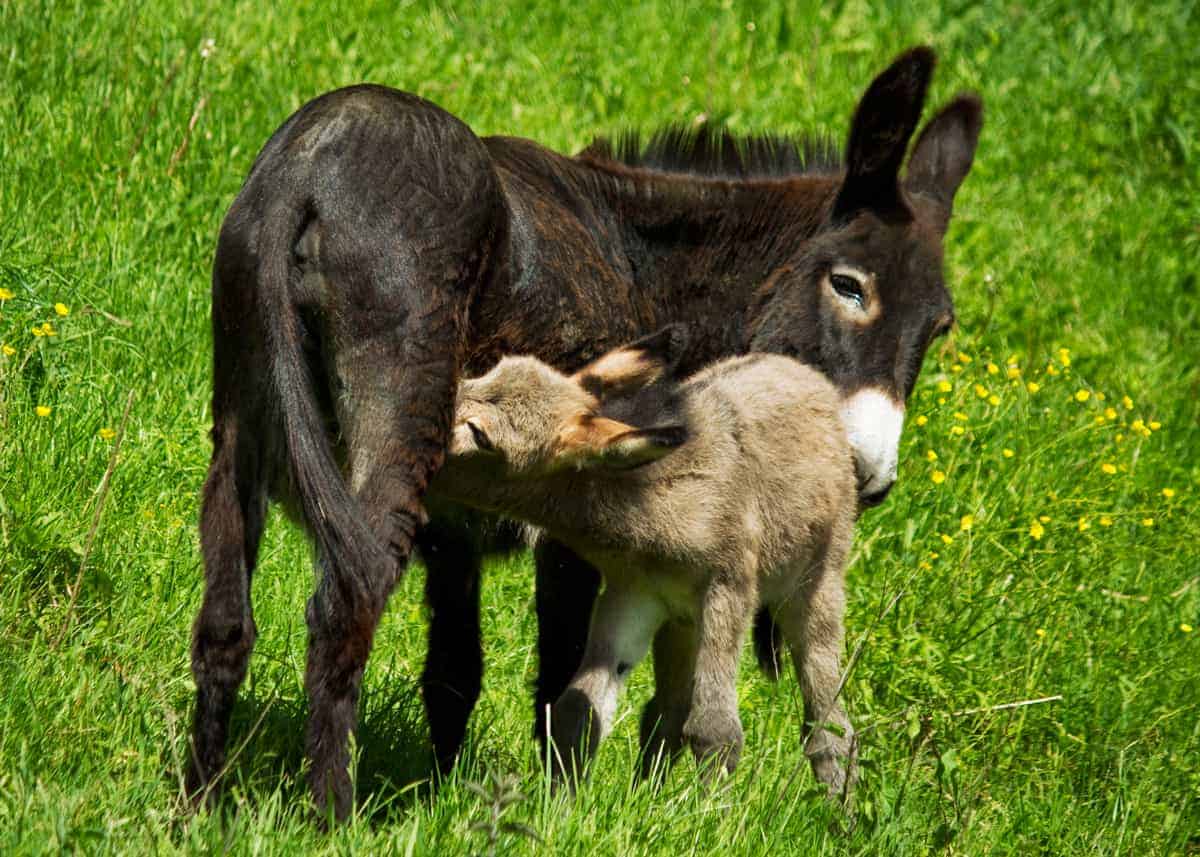
40. Do donkeys grieve?
Donkeys have exhibited signs of grief after the death of a herd member. One display of mourning even made headlines when it was captured on video.
In 2014, a Swedish animal sanctuary had to put down an elderly donkey that was very sick, and his herd mates gathered around his body and started braying in distress. One donkey even tried to revive him with nudges and bites.
41. How many donkeys are in the world?
There are currently around 41 million donkeys living on almost every continent on Earth. While they aren’t endangered, their numbers have been slowly declining over the years, and there are certain species of wild donkeys that are vulnerable to extinction.
For example, the International Union for Conservation of Nature (IUCN) reports that the African wild ass is down to less than 200 mature adults. This makes them a critically endangered species even if donkeys aren’t endangered as a whole.
42. 4 Famous Donkeys in Pop Culture
Donkeys have been featured in everything from animated children’s movies to depressing dystopian novels. Let’s take a look at some of the most famous of these critters.
- Eeyore: This mopey donkey needs no introduction. One of the staple characters from Winnie the Pooh, he’s probably the single most famous donkey in the world. Just don’t expect that news to cheer him up.
- Donkey: His name might not be the most creative, but if you shout “Donkey!” in just the right accent, everyone will know that you’re referring to the wise-cracking donkey from the Shrek movies.
- Puzzle: Puzzle was a donkey in The Chronicles of Narnia who was tricked into betraying the great lion Aslan. His name was both a warning and a dose of irony.
- Benjamin: You might not recognize Benjamin by name, but he was the donkey from George Owell’s Animal Farm who served as a representation of the older Russian generation during the spread of communism in the Soviet Union. Yeah, he was a riot.
43. 6 Donkey Expressions and Proverbs
Donkeys have been around for so long that they’ve crept into quite a few idioms and expressions. While this isn’t anywhere near a complete list, it might give you an idea of how much donkeys are a part of our language, culture, and history.
- Donkey’s years. If you haven’t seen someone in a donkey’s years, you haven’t seen them in a long time.
- Pin the tail on the donkey. This is a children’s game involving blindfolds that can also be used to describe a pointless or frustrating task.
- Talk the hind legs off a donkey. Since donkeys don’t usually sit or lie down, this expression means that someone has talked for so long that they’ve even managed to wear down a donkey.
- A donkey in a lion’s skin. This comes from an old fable about a donkey dressing up in a lion’s skin to fool the other animals. Eventually, he brayed and gave himself away, so the moral of the story is that people can’t fool you once they open their mouths.
- There are also a number of expressions about donkeys in other languages. For example, “a donkey walking backward” is part of a French phrase talking about dishonesty.
- “Wearing donkey ears” is used to describe foolishness in Russia.
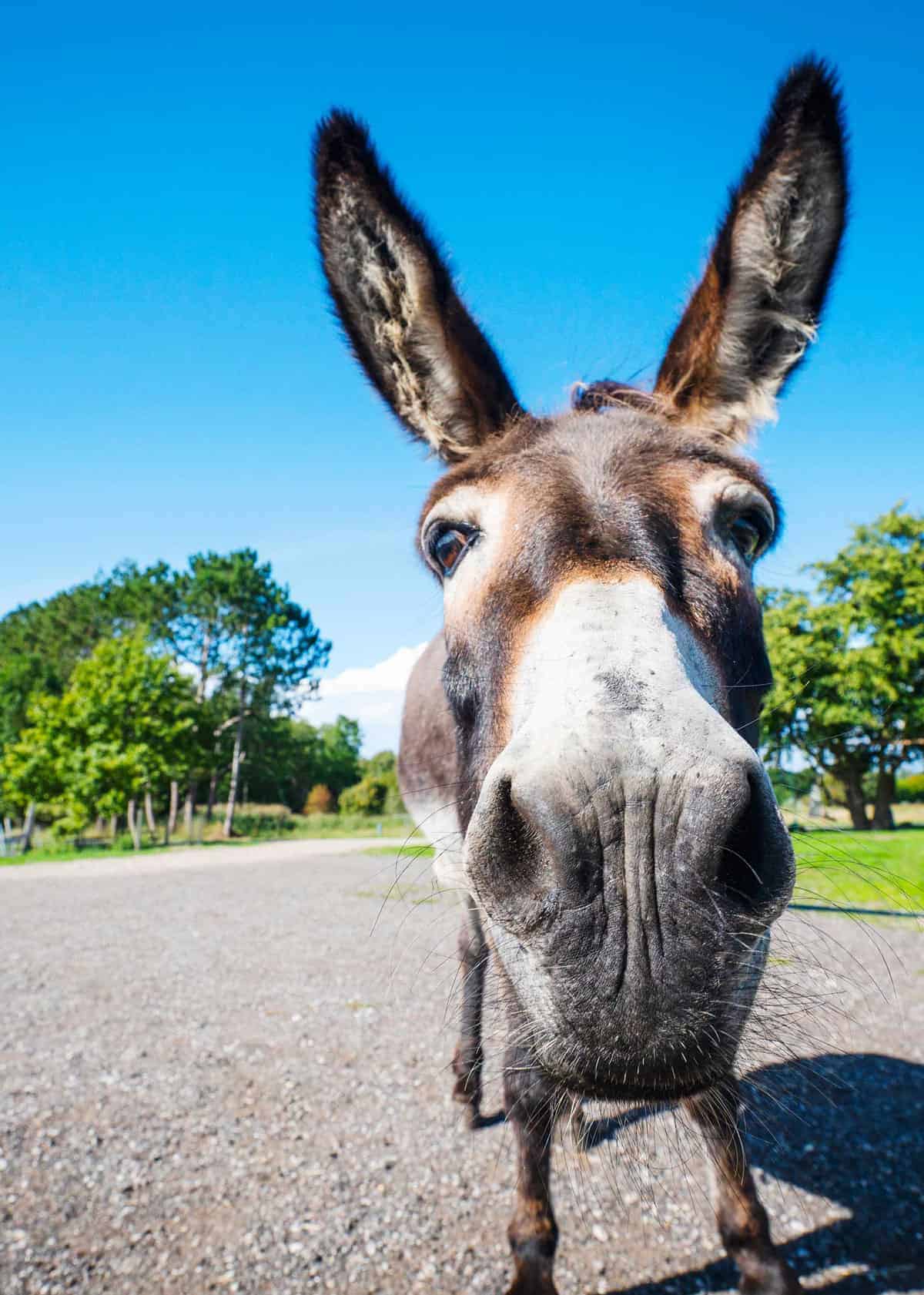
The Funniest Animal of Them All
What do you think about our donkey facts? Did you learn anything new? Is there anything important that we didn’t cover? There’s still so much to learn about a species that’s creating new breeds every day.
We think donkeys are some of the funniest and most fascinating animals around. It’s a donkey’s world, and we’re just living in it!







nice article
Thank you so much. Wonderful facts. Putting your site in my book as I have a Donkey in the mix. You Rock!!!!!
Thankyou very much!
Quite a lot of information about donkeys.
Never heard many of these things.
I only knew donkeys as transport animals. I am surprised to know that they can also perform guard duty, and they can be pet animals.
I heard that celebrity women down the ages, including Cleopatra, the queen of Egypt, used to bathe in donkey’s milk to maintain their beauty. It it is a fact, may be it can be included in this narrative!
I live in Arizona and I get to have my first ever visit to a donkey sanctuary tomorrow!!! I happened upon this article and I’m over-the-moon delighted with all this information!!! I will try to share with the owners too!! I’m looking forward to getting some donkey-love!! I can’t imagine petting those wonderous ears!!!
Thank you so much for this great read!!!💙
I am slowly changing my mind from acquiring a miniature horse to a mini donkey. This was informative reading, since I know nothing it about donkeys.
I am sure that 2 mini donkeys would be more fun than just one miniature horse.
I love the colors that some farms produce. I live in the state of Connecticut. Is it known where these colorful beauties are bred?
Fabulous information 💜‼️ I have always had animals, birds & bees . Four cats & four dogs at this time . I think I would love to have a little donkey . What is the best way to find a bgood breeder?
While in Lancaster PA, my family and I spotted about 8-10 donkeys in a field. It was raining very lightly and they were all sanding the same and facing the same direction. They were all in a kind of in a cluster. I was curious, is this usual behavior for them and why?
You mentioned a record weight of 1300 pounds. What are the typical weight ranges for donkeys?
What are their typical lifespans like?
I got a donkey when I was a young teen. We trained the donkey to be ridden. She took me all over the fields and through the woods. She had a lot of energy and would walk, trot and canter when asked. Later we got a horse. He worshipped the donkey. She acted like she could care less. She bossed him around. When I took her out for a ride, he’d run the fence line calling for her. I loved that donkey.
What a beautiful story Barb. My grandkids enjoy and ride my mini’s.
Seems like everyone has 7 donkeys .
Today I just got a mini donkey. I am so very excite , my grand dad had them when I was a kid in Maine. We so enjoyed summers at Grammy and Grampa’s.
Thank you for the fun facts about how fabulous they are to the world.
I did want to know how they slept and now I do . Blessings and stay safe with your travels. Happy Trails to you…until we meet again…Roy Rogers!!
I live in South Africa and have seven donkeys. Five of them are spotted (one with blue eyes) and two white donkeys with blue eyes. I did’nt realise that white donkeys with blue eyes are so rare, as I know of a few other people in SA who also possess them.
I live in South Africa and have seven donkeys. Five of them are spotted (one with blue eyes) and two white donkeys with blue eyes. I did’nt realise that white donkeys with blue eyes are so rare, as I know of a few other people in SA who also possess them.